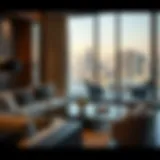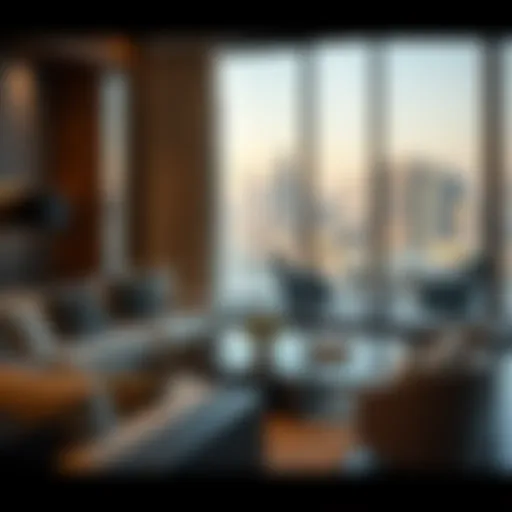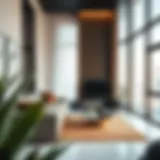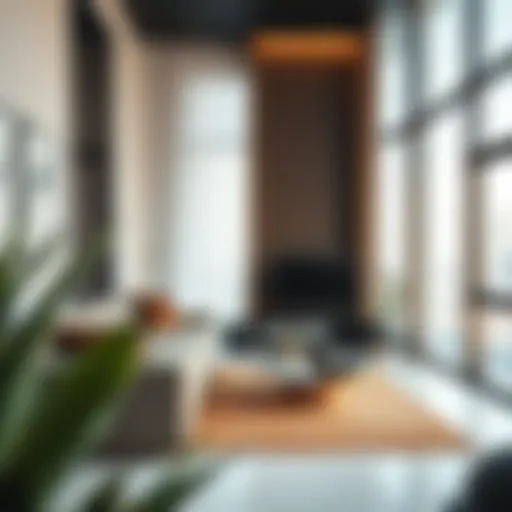Insight into Light Commercial Towers in Dubai
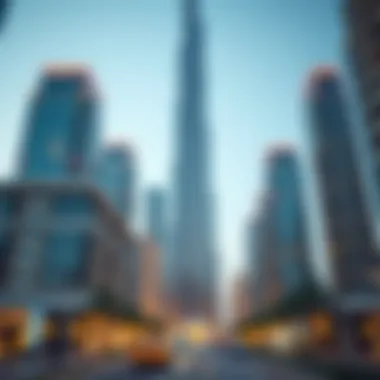

Intro
The light commercial towers in Dubai stand out as cornerstones in the city’s rapidly growing skyline. They're more than just structures; they represent a blend of innovative design and strategic investment opportunities. As Dubai continues to blossom, these buildings serve crucial functions, catering to businesses that demand excellent locations paired with modern amenities. In this article, we’ll dive deep into what makes these towers significant, unravel their architectural features, and scope out the current market trends shaping their development.
Understanding the dynamics of light commercial towers is essential for anyone looking to invest, manage, or even rent within this niche sector of real estate. It’s not merely about bricks and mortar; these towers influence the economic fabric of Dubai, creating spaces that foster growth and connectivity. This examination will delve into the market analysis, revealing current trends, historical performance, and the underlying factors that contribute to effective investment strategies.
The evolution of light commercial towers also mirrors the city's ambitions and adaptiveness to global changes, making it a fascinating study for real estate enthusiasts, investors, and developers alike. As we explore, we will identify the best areas for investment and understand the mechanisms behind property value appreciation, providing crucial insights that will help shape your decisions in the bustling market of Dubai's commercial landscape.
Understanding Light Commercial Towers
In the heart of a booming metropolis like Dubai, light commercial towers serve as pivotal structures that fuel economic activity and urban growth. They represent a unique blend of functionality and aesthetics, catering to various business needs from office spaces to retail units. Understanding these towers is crucial for investors, realtors, and developers alike, as the demand for versatile commercial spaces continues to rise, driven by the dynamic local economy.
Definition and Characteristics
Light commercial towers can be described as multi-story buildings designed primarily for commercial use. Unlike traditional skyscrapers, which often house large corporate offices, these towers are developed to accommodate smaller businesses, startups, and retail enterprises. This differentiation is essential, as it aligns with Dubai's vision of fostering entrepreneurship and economic diversification.
Some defining characteristics of light commercial towers include:
- Scalable Spaces: They often feature flexible floor plans that can be adapted to meet the specific needs of various tenants.
- Strategic Location: Many of these towers are situated in prime areas, offering easy accessibility for both customers and employees.
- Mixed-Use Capabilities: A notable number host a mix of office, retail, and sometimes residential spaces, enhancing community interaction and convenience.
- Architectural Style: Typically, these structures present modern and innovative designs, appealing to a wide range of businesses and enhancing the urban skyline.
To put it simply, light commercial towers are a vital cog in the wheel of ongoing urban development in Dubai. They embody the shift towards creating inclusive, multifaceted environments that encourage collaboration among different sectors.
Distinction from Other Commercial Buildings
While exploring light commercial towers, it's essential to understand how they differ from other types of commercial buildings—most notably, traditional office towers and retail malls. The key distinctions lie in their intended use, design, and scope of operations:
- Target Audience: Light commercial towers cater primarily to small to medium-sized enterprises. In contrast, traditional office buildings tend to attract larger corporations and higher-end tenants.
- Design and Functionality: The emphasis in light commercial towers is often on creating vibrant spaces with a mix of functions rather than focusing solely on office workspaces. This can include co-working spaces, pop-up shops, and small cafes that cater to diverse visitors.
- Community Engagement: These towers are more likely to promote social connectivity, integrating spaces for networking, relaxation, and collaboration, versus the more isolated nature of standalone office structures.
In essence, light commercial towers are redefining the landscape of commerce in Dubai. By serving a specific niche and promoting flexibility in urban design, they not only contribute to the economic framework but invigorate community life, making them indispensable facets of future urban planning.
The Historical Context of Light Commercial Towers in Dubai
Understanding the historical context surrounding light commercial towers in Dubai is pivotal for grasping their current significance and future trajectory. These structures don’t simply inhabit the skyline; they mirror the growth and transformation of the city's commercial landscape. The past offers valuable lessons that investors and industry stakeholders can leverage to navigate the present market dynamics.
Evolution of Commercial Spaces
Dubai's commercial spaces have undergone a remarkable evolution over the past few decades. In the early days, the city primarily hosted small shops and traditional marketplaces known as souks. As oil wealth began to shape the region, there was a push towards modernization. The onset of the 1990s witnessed a surge in larger, more structured commercial spaces. These developments reflected not just an architectural ambition but a strategic shift towards creating an economic hub in the Middle East.
As the city expanded, light commercial towers emerged in response to evolving needs. Unlike their heavyweight counterparts, these towers offered flexibility and a modern aesthetic suitable for start-ups and small to medium enterprises. They began to populate key areas such as Dubai Media City and Dubai Internet City. The features of these spaces are tailored to support innovative ventures, making them attractive venues for budding entrepreneurs.
Dubai's commitment to diversifying its economy shifted focus to knowledge-based industries and technology. The rise of light commercial towers epitomizes this transition, acting as incubators for businesses that drive the city’s future. By offering a mix of workspace environments, these towers cater to a diverse tenant base.
Government Policies and Regulations
The government plays a critical role in shaping the landscape of light commercial towers through policies and regulations. Over the years, initiatives aimed at fostering entrepreneurship and attracting foreign investment have sparked a boom in this sector. Policies such as the Dubai Free Zones, which allow 100% foreign ownership and offer tax incentives, have made the city an appealing destination for international businesses.
Moreover, the Urban Planning Department of Dubai has outlined clear regulations guiding the design and construction of commercial buildings. These rules ensure that developments align with urban development goals, considering both sustainability and communal impact. Investors must stay informed about these regulations, as compliance can greatly influence the profitability and viability of light commercial spaces.
"Government policies not only drive economic growth but also set the foundation for sustainable development in commercial real estate."
The evolution of light commercial towers also mirrors broader global trends towards increased emphasis on sustainability and efficiency. Innovations in building materials and technologies have been encouraged by the government, thus enhancing property value and tenant satisfaction.
In summary, the historical context of light commercial towers in Dubai is one of rapid evolution driven by economic motivations and guided by supportive government policies. Understanding this history helps investors foresee the potential of these towers in shaping future commercial landscapes.
Architectural Features
The architectural features of light commercial towers are pivotal not only in defining the physical space but also in influencing user experiences and shaping urban identities. The design and structure of these towers reflect both the cultural essence of Dubai and the functional needs of modern businesses. As the city continues to evolve, the architecture of light commercial towers embodies a blend of aesthetic brilliance and practical utilitarianism.
Design Innovations
In a constantly changing market, design innovations are the bedrock of what makes light commercial towers in Dubai stand out. Architects have ventured beyond the conventional, leveraging unique shapes, bold facades, and striking materials that capture the attention of passersby.
One prominent example is the use of biomimicry in design—structures that mimic nature's forms and functions, not only to attract tenants but also to enhance sustainability. For instance, the ripple effects in building cladding that reduce heat absorption also add an artistic flair.
Another trend involves adaptive reuse, where older buildings are transformed into vibrant commercial spaces, harmonizing the new with the old. This not only preserves the rich history of Dubai but also introduces innovative space solutions that appeal to young, dynamic companies seeking creativity in their work environment.
Sustainability Considerations
In an era where environmental consciousness is paramount, the architectural features of light commercial towers heavily focus on sustainability. Many of these buildings integrate eco-friendly materials and energy-efficient systems that significantly reduce their carbon footprint. For example, Dubai's latest projects have incorporated solar panels and green roofs, promoting energy conservation while enhancing aesthetics.
Furthermore, rainwater harvesting systems are increasingly common, allowing buildings to manage water resources effectively. Not just about the environment, such sustainable choices can also lead to significant cost savings for tenants, making these spaces appealing investment opportunities for business owners.
"Sustainability is not just a trend; it is becoming a fundamental principle of architectural design in commercial spaces."
Technology Integration
Light commercial towers are also at the forefront of integrating advanced technologies that redefine the work environment. Smart building solutions, including automated lighting and climate control systems, enhance the efficiency of space use while ensuring occupant comfort.
Moreover, with the rise of the Internet of Things (IoT), these towers enable seamless connectivity and management. Businesses can utilize smart sensors to monitor energy usage and optimize operations, which fosters not just convenience but also reduces operational costs.
Security is another realm where technology plays a significant role—biometric access controls and sophisticated surveillance systems ensure safety for both occupants and visitors, which is a vital consideration in urban settings.
In summary, the architectural features of light commercial towers in Dubai are a reflection of innovation, sustainability, and technological prowess. Understanding these elements is crucial for investors and tenants who seek to navigate this dynamic real estate landscape effectively.
Market Trends and Demand Analysis
Understanding the market trends and demand analysis for light commercial towers in Dubai is crucial. This dynamic sector not only reflects the vibrancy of the city’s economy but also highlights shifting preferences among businesses and consumers. Analyzing these market trends provides insights into how the real estate landscape is evolving, which in turn informs potential investments and developments. By grasping the current dynamics and future attractions within this niche, stakeholders can make informed decisions.
Current Market Dynamics
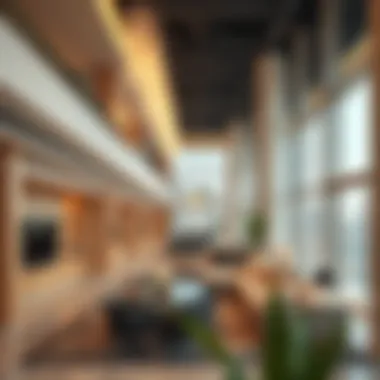
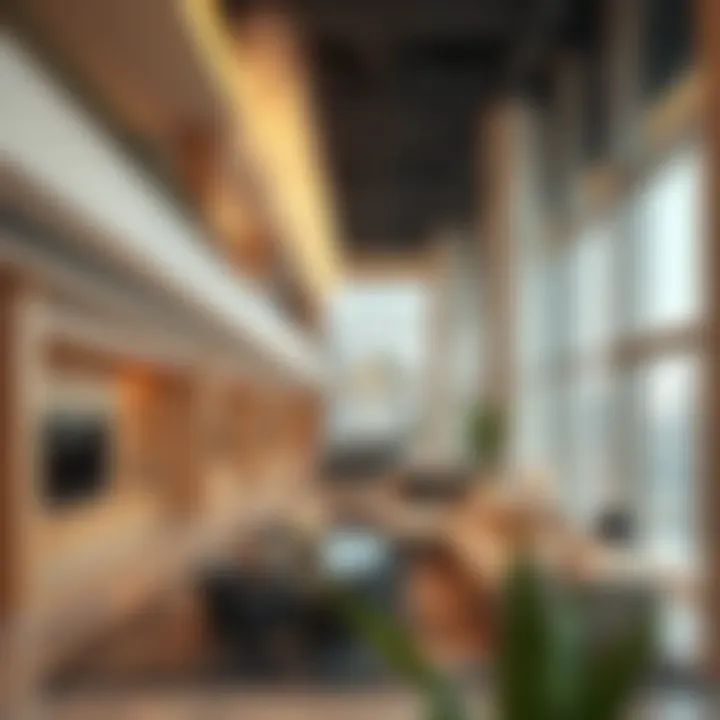
The pulse of the Dubai light commercial market can be best described as lively and ever-changing. Several elements contribute to the current market dynamics:
- Rising Demand for Flexible Spaces: More businesses are leaning towards co-working environments and flexible office spaces. This trend is largely driven by the rise of startups and remote work. Firms prefer arrangements that can be adjusted based on their short-term needs.
- Diverse Tenant Profiles: Light commercial towers are appealing to a variety of tenants including tech firms, creative agencies, and service-oriented businesses. This diversification cultivates a unique environment where companies thrive together, sharing resources and ideas.
- Rejuvenating Neighborhoods: Areas around light commercial towers are undergoing redevelopment, making them attractive for both businesses and employees. New infrastructure and amenities are cropping up, enhancing the overall environment.
- Investment Hotspots: With the ongoing Expo 2020, Dubai is drawing in international interest. Institutions and individuals alike are keen on investing in this segment, seeing light commercial towers as strategic investments with promising returns.
"As global trends shift towards more collaborative and dynamic work environments, light commercial towers in Dubai are emerging as the go-to solution for modern businesses."
Investment Attractions
Investors looking at light commercial towers in Dubai may find that the landscape offers several notable attractions:
- High Returns on Investment: Given the increasing demand for commercial spaces, light commercial towers promise viable rental income. Investors can expect higher yields than traditional office spaces, primarily due to the unique offerings that cater to the modern workforce.
- Favorable Government Regulations: The government has put forth various initiatives aimed at attracting foreign investments. Factors such as eased restrictions on property ownership for non-UAE nationals play a significant role in augmenting investor confidence.
- Technological Advancements: The integration of smart technologies within these towers is transforming how businesses operate. From energy-efficient systems to advanced security features, investments in technology can boost property values, further attracting potential buyers and tenants.
- Strategic Economic Vision: Projects aligned with Dubai's long-term economic plans, like the Dubai 2040 Urban Master Plan, create a promising backdrop for investments in light commercial towers. This visionary approach is setting the stage for sustainable growth, thus enticing investors.
Location and Accessibility
When it comes to light commercial towers, the principle of location and accessibility cannot be understated. These are not just mere buildings; they serve as hubs of activity and business. Thus, understanding where they stand and how well they connect to their surroundings becomes pivotal for investors, developers, and businesses eyeing potential growth in Dubai’s burgeoning market.
Dubai, known for its strategic geographic position, offers numerous prime zones for establishing light commercial towers. It's almost like looking for a needle in a haystack, but the right location can either make or break a business. The ideal spots are often characterized by high foot traffic, proximity to essential services, and sufficient visibility. Investors usually flock towards areas like Downtown Dubai, Business Bay, and Dubai Marina, where amenities and business potential coalesce beautifully.
Moreover, being based in a strategic location can greatly enhance a company's profile, giving it that extra edge in competitiveness. Here’s what to consider when evaluating locations within Dubai:
- Visibility and Branding: Towers situated in prominent locations easily become landmarks in themselves. This provides businesses with recognition and reputation.
- Proximity to Clients: Being near competitors or complementary businesses can encourage collaborations and increase customer visits.
- Access to Talent: If a company can attract skilled workers by being located near amenities like schools and residential areas, it stands to gain.
"Choosing the right location isn't just about the view; it's about the people who see it every day."
The considerations for locations in Dubai's light commercial sector extend into the logistics of accessibility.
Strategic Locations within Dubai
Well, let’s talk nitty-gritty about those strategic locations. Each neighborhood in Dubai offers a unique flavor, and selecting one that aligns with the intended business model is vital. Some standout locales include:
- Business Bay: An established hub that's teeming with skyscrapers. Its proximity to Downtown Dubai makes it ideal for businesses looking for a central spot. The sheer number of companies here also amplifies networking chances.
- Dubai Marina: A desirable district that not only caters to locals but also attracts international clientele. Its restaurant and entertainment scene can draw potential customers to light commercial spaces, enhancing foot traffic.
- Jumeirah Lake Towers (JLT): A favored choice due to its balanced mix of residential and commercial spaces. It's like having the best of both worlds—offering access to both professional networks and a vibrantly engaged community.
- Deira: The older part of Dubai; it brings a rich tapestry of culture. Light commercial towers here benefit from established markets and are well-connected to transport infrastructures, attracting those who appreciate tradition along with modernity.
Transport Infrastructure
Next up is transport infrastructure, a backbone for any growing city. Dubai is a marvel when it comes to connectivity, and the integration of light commercial towers into this web of transport is crucial. Here are several key features:
- Metro Lines: The Dubai Metro offers a seamless transit option, and light commercial towers near metro stations usually enjoy heightened visibility and foot traffic. It’s a no-brainer for businesses that want easy access for clients and employees alike.
- Major Highways: Major highways that circle and situate Dubai make transport incredibly efficient. Towers close to roads like Sheikh Zayed Road open routes to other emirates, benefiting companies with broader markets.
- Buses & Taxis: Public transport is widely used in Dubai. Towers positioned near bus stops or taxi ranks make it easier for customers to visit, which in turn can bolster sales.
- Accessibility for Pedestrians: The best buildings come with thoughtful designs that encourage pedestrian movement. Walkways and biking lanes can increase the chances of customers popping in for a visit.
Types of Light Commercial Spaces
Understanding the types of light commercial spaces available in Dubai offers valuable insights not just for investors but also for entrepreneurs and business owners. These distinct spaces cater to diverse business needs, fostering innovation and collaboration in the bustling environment of Dubai. Through this lens, one can appreciate how these spaces contribute to the overall commercial ecosystem in the city.
Co-Working Environments
Co-working spaces are a game changer in today’s business landscape. They provide flexible options for established companies and startups alike, allowing them to rent space as needed. Unlike traditional office setups, these environments foster collaboration among diverse businesses, nurturing ideas and encouraging networking.
- Flexibility: They allow businesses to scale up or down without long-term commitments.
- Affordability: Lower operational costs compared to leasing entire floors or buildings.
- Community Building: Access to a vibrant community of like-minded professionals.
Investors are keen on co-working spaces, noting their increasing demand, driven largely by the growing gig economy and remote work trend. A successful example in Dubai is WeWork, which has become synonymous with flexible office environments, attracting a wide array of tenants from freelancers to medium-sized firms.
Retail Units
Retail units located within light commercial towers play a crucial role in enhancing consumer experience, transforming buildings into vibrant hubs. In a market that abounds with choices, these spaces must cater to evolving customer preferences while providing easy access to essential services.
- Diversity of Offerings: From boutiques to cafes, retail units enrich the commercial appeal of light towers.
- High Foot Traffic: Locations within or around major business districts usually guarantee visibility and customer access.
- Brand Collaboration: Retailers in these spaces often band together, creating a cohesive shopping experience.
As consumers continue to seek convenience, the integration of retail units within light commercial towers enhances the overall value of these spaces. Investors can take advantage of the sustained interest in retail as online purchases continue to blend with physical shopping experiences.
Service Offices
Service offices provide a unique blend of flexibility and professionalism. Equipped with essential amenities and support services, these offices appeal to businesses needing fully-fledged facilities without the overhead of traditional leasing.
- Turnkey Solutions: Ready-to-use office spaces reduce setup time, allowing businesses to operate immediately.
- Support Services: Administrative assistance, IT support, and meeting rooms can be included in the lease, streamlining operations.
- Scalable Options: Businesses can adjust their office needs as they grow, minimizing risk and maximizing efficiency.
The demand for service offices continues to surge as startups and international firms look for cost-effective solutions in a competitive market.
"The choice of office space can seriously impact business performance; flexibility is the new luxury."
Ending
The diverse types of light commercial spaces in Dubai contribute significantly to the city’s evolving business landscape. By understanding these spaces, investors and business owners can make informed decisions tailored to their unique needs. As the market matures, the focus on co-working environments, retail units, and service offices will remain vital in keeping pace with trends and challenges that arise in this vibrant city.
Investment Considerations
Investment Considerations are paramount in understanding the light commercial tower market in Dubai. As this sector evolves, potential investors must navigate through a myriad of factors that influence their decisions. These considerations impact not only the capital but also the sustainability and long-term viability of their investments. In analyzing light commercial towers, several specific elements come into play, including market dynamics, expected returns, and risk assessments.
Cost-Benefit Analysis
When investing in light commercial towers, a detailed cost-benefit analysis is essential. This analysis helps in illuminated the potential profits alongside the costs incurred throughout the entire investment cycle.
A comprehensive assessment will delve into several critical elements:
- Initial Investment Costs: This includes the purchase price of the property, cost of renovations, and potential fees for legal services.
- Operational Expenses: Regular outlays such as maintenance, property management, utilities, and taxes can erode profits if not planned adequately.
- Potential Rental Income: Understanding the rental market prices in the area can guide expectations about income generation.
- Long-term Appreciation: The value of commercial properties tends to rise over time. Recognizing the factors that contribute to property value in Dubai, such as urban development plans, is crucial.
- Exit Strategies: The ease with which an investor can sell their stake is central to maintaining liquidity. A well-formed strategy ensures that avenues for profit realization are viable and accessible.
On a grander scale, this analysis aids investors in pinpointing profitable opportunities while considering the risks associated with real estate in Dubai.
Financing Options
Financing light commercial towers involves deliberations on different routes to secure necessary capital. Investors have a variety of options available to them:
- Traditional Bank Loans: Securing a mortgage from local banks is a standard route, albeit often requiring significant documentation and adherence to strict credit criteria.
- Private Investors or Venture Capital: For those who prefer less conventional routes, attracting private investors offers a way to pool resources without the constraints of traditional lending.
- Real Estate Investment Trusts (REITs): These allow for shared ownership in properties and can be an accessible means for smaller investors to partake in larger investments without the requirement of managing properties themselves.
- Crowdfunding Platforms: Emerging platforms provide an innovative approach, allowing multiple individuals to invest small amounts in larger projects, ultimately democratizing commercial real estate investing.
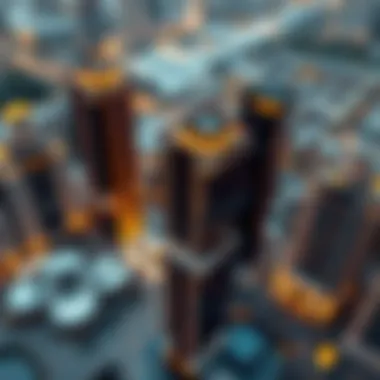

Understanding these financing options is crucial for investors. Each route carries its pros and cons, influencing not only the development of the project but its ultimate success in Dubai's robust real estate landscape.
As challenging as it may seem initially, the potential returns from well-researched investments in light commercial towers could very well outweigh the inherent risks involved.
All in all, navigating investment considerations necessitates a keen understanding of costs and financing pathways. It requires a strategic approach to elucidate the intricacies of the market, paving the way for informed, lucrative decisions.
Challenges in the Light Commercial Tower Sector
The light commercial tower sector in Dubai, while brimming with opportunities, encounters several challenges that can pose significant hurdles for investors, developers, and property owners. Understanding these challenges is crucial for anyone engaged in this market, as recognizing potential pitfalls can help inform strategic decision-making. The depth of this analysis sheds light on the realities of investing in commercial real estate, offering insights vital for navigating through Dubai's complex real estate landscape.
Market Saturation
One of the predominant challenges facing the light commercial tower sector is market saturation. Over the past decade, Dubai has seen an influx of light commercial developments. While this growth has fueled the economy and provided a variety of commercial spaces, it has also led to an oversupply in certain areas. With numerous towers sprouting up like wildflowers, the competition has intensified.
This saturation often results in rental price reductions, which can sting for property owners and developers who may have anticipated higher returns on their investments. As space availability increases, prospective tenants have the upper hand; they are likely to shop around for favorable lease terms, further driving down rates. In some instances, property owners have reported vacancy rates creeping up, which can be detrimental to cash flow and ultimately hinder long-term viability.
The challenge isn't just maintaining occupancy; it's about distinguishing one's property in a crowded market. Many towers offer similar amenities and features, making it tough for landlords to attract and retain tenants. This calls for innovative marketing strategies and unique service offerings.
In essence, navigating market saturation requires vigilance. Key strategies might include emphasizing location advantages, providing bespoke amenities, or venturing into niche markets—such as co-working spaces—to stay ahead of the game.
Regulatory Hurdles
Regulatory hurdles present another significant challenge for light commercial towers in Dubai. Navigating the maze of local laws, building regulations, and licensing requirements can feel like trying to find a needle in a haystack. Developers often face stringent approval processes before construction can even begin. For instance, zoning regulations can restrict the types of businesses permitted in light commercial spaces, affecting potential tenants and overall tenant mix.
Moreover, the government’s regulations can shift based on economic policies or environmental considerations. Such changes may necessitate costly adjustments to projects already underway. For example, requirements for sustainability features have become more prescriptive as Dubai aims for greener urban development. While these regulations are essential for promoting sustainable growth, they can sometimes delay project timelines and inflate budgets.
The regulatory landscape is also notable for its complexity. Developers may need to liaise with various governmental bodies, including the Dubai Land Department and the Building Department, each with its own set of rules and paperwork. This can lead to lengthy delays that frustrate stakeholders and shift project timelines.
Overall, understanding and adapting to these regulatory hurdles is vital for success in Dubai's light commercial tower sector. Developers who invest time in familiarizing themselves with the laws and regulations, along with building robust relationships with local authorities, tend to fare better in the long run.
"In the bustling scene of Dubai’s real estate, awareness of regulations not only streamlines processes but also catalyzes success through innovation and compliance."
Future Prospects
The future of light commercial towers in Dubai presents a landscape ripe with opportunities, driven by rapid urbanization, technology integration, and changing consumer demands. This section focuses on identifying pivotal elements that outline not just the potential growth of these structures but also their role in shaping both the urban environment and the economy. Investors, realtors, and developers need to keep their ears to the ground on evolving trends in this segment, as they will inform critical investment and strategic decisions going forward.
Innovations on the Horizon
Innovation is no longer a luxury in the real estate sector; it's a necessity. As Dubai continues to position itself as a global business hub, light commercial towers must adapt to technological advancements and market requirements.
- Smart Technologies: The integration of smart technologies in light commercial towers is one of the most significant trends. Features like automated lighting systems, smart HVAC, and energy-efficient appliances not only reduce costs but also enhance user experience. The installation of IoT sensors can offer valuable data for operational efficiency, leading to smarter resource management.
- Modular Construction: This methodology is gaining traction in the Dubai market. Modular construction allows for quicker build times and flexibility. Developers can respond to market demands more adeptly by adjusting the size and scope of projects based on current trends, ensuring that the towers they create are functionally viable.
- Sustainability Innovations: As sustainability continues to command attention, developers will need to focus on greener practices. Solar panels, green roofs, and rainwater harvesting systems could become standard fixtures in these towers. This aligns not only with global trends but also with local regulations aimed at enhancing the livability of urban environments.
The mergers of these innovations into future light commercial designs will likely create spaces that are not only aesthetically pleasing but also highly functional and environmentally responsible.
Predicted Market Shifts
The market for light commercial towers is not static; it evolves based on economic conditions, social behavior, and technological advancements. Here are key shifts to keep an eye on:
- Increased Demand for Flexibility: Post-pandemic, there's been a notable shift towards flexible work environments. As businesses lean more toward hybrid work models, light commercial spaces that offer adaptable layouts will become more desirable. Expect an increase in co-working spaces and short-term lease options within these towers.
- Demand for Mixed-Use Developments: The lines between work, leisure, and living are becoming increasingly blurred. Future light commercial towers are likely to incorporate mixed-use designs that combine office spaces, retail outlets, and residential units. This will not only maximize the utility of the space but also contribute to a sense of community, encouraging foot traffic and long-term tenant retention.
- Increased Investment from Foreign Entities: Dubai’s geopolitical position and favorable tax environment have already appealed to many foreign investors. This level of interest is projected to rise, leading to a surge in funding for light commercial towers. Investors looking to capitalize on this trend will find opportunities in newly emerging areas as well as established neighborhoods undergoing revitalization.
"Investors must remain vigilant and agile to navigate the complexities of the evolving market dynamics."
Keeping these shifts in mind helps industry stakeholders better anticipate challenges and opportunities, pivotal for strategic planning in an ever-changing landscape.
Case Studies of Successful Light Commercial Towers
Analyzing case studies of successful light commercial towers offers a wealth of insight into their operational and financial viability. These real-life examples serve as blueprints for potential investors and developers, illustrating best practices and innovative solutions that can lead to success in this competitive sector. Not only do these towers deliver functional space, but they also embody the economic pulse of Dubai, reflecting its aspirations and growth trajectory in the commercial real estate market.
Highlights from Prominent Projects
One standout example is the Jumeirah Business Center 1, located in the heart of the Dubai Media City. This tower exemplifies the ideal blend of aesthetic appeal and practical utility, providing flexible office spaces coupled with state-of-the-art amenities. Tenants can enjoy high-speed internet and modern meeting rooms, which cater to both local and international businesses.
Another noteworthy project is the Index Tower. Standing tall in the Dubai International Financial Centre, it showcases innovative architectural design, and incorporates eco-friendly features which resonate with the growing emphasis on sustainability in real estate. Its strategic positioning within a key economic zone significantly boosts its desirability among renters.
Moreover, the Business Bay area is home to a plethora of light commercial towers, among which the Bay Square Towers are remarkable. These towers focus on creating a community feel with interconnected spaces that promote networking. This approach has attracted various small and medium enterprises, making it an attractive spot for startups.
Lessons Learned
From these examples, several lessons emerge that can guide stakeholders in the light commercial sector:
- Flexibility is Key: Developers need to design spaces that can accommodate evolving business needs. Open floor plans, adjustable office sizes, and collaborative spaces can attract a wider range of tenants.
- Sustainability Matters: Investing in green technologies not only reduces operational costs but also appeals to tenants who value environmental responsibility. Projects like the Index Tower demonstrate that eco-friendly features can enhance marketability.
- Community Focus: Building a vibrant community around the tower can significantly boost tenant retention. The integration of communal areas and event spaces encourages interaction and fosters collaboration.
- Location, Location, Location: The strategic placement of commercial towers remains crucial. Close proximity to transport hubs and essential amenities can directly influence occupancy rates and rental prices.
The Role of Technology in Light Commercial Towers
Light commercial towers in Dubai are not just structures; they are a manifestation of integration between architecture and technology. The role of technology in these establishments cannot be overstated as it influences the functionality and efficiency of the services they offer. By harnessing cutting-edge innovations, these towers can enhance user experience, optimize operational performance, and garner significant investment returns. As businesses and investors look for smart solutions that promote sustainability, technology stands front and center in the evolution of light commercial towers.
Smart Building Solutions
Smart building solutions are revolutionizing how light commercial towers operate. These innovations encompass a wide range of technologies aimed at creating efficient, responsive environments. One of the most significant aspects is the utilization of Internet of Things (IoT) devices, which enable real-time monitoring of various building functions such as energy consumption, occupancy levels, and HVAC systems.
Benefits of Smart Building Solutions:
- Energy Efficiency: Smart meters can optimize energy usage, leading to reduced operational costs and lower carbon footprints.
- Enhanced Security: Advanced surveillance systems and access control can ensure safety without hindering accessibility.
- Improved Comfort: Automated systems can adjust lighting and temperature based on occupancy and weather conditions, providing a comfortable environment for tenants and visitors.
The ongoing shift toward smart technology in light commercial towers signifies a growing investment in future-readiness.
Using mobile apps or integrated dashboards, building managers can gain critical insights about the building's performance and make data-driven decisions. For instance, a business owner in a light commercial tower can automate lighting based on daily schedules or even use predictive maintenance to avoid unforeseen repairs. This not only streamlines management but also improves tenant satisfaction with a more stable environment.
Digital Transformation Trends


With the rapid evolution of digital technology, light commercial towers are at the forefront of embracing digital transformation. This trend transcends mere automation; it signifies a fundamental change in how buildings are designed, managed and utilized.
Key Trends in Digital Transformation:
- Cloud Computing: Accessibility to building data from anywhere enhances management responsiveness.
- Big Data Analytics: By analyzing occupancy patterns, companies can make strategic decisions regarding space utilization and leasing, optimizing their opportunities.
- Virtual and Augmented Reality: These technologies are increasingly used for design and visualization, allowing potential investors to view projects before they’re built, enhancing decision-making.
Digital transformation in such towers also extends to the way businesses interact with their clients. Using online platforms, businesses can host virtual meetings, or even create entirely immersive experiences for their customers, transforming service delivery.
Community Impact of Light Commercial Towers
Light commercial towers in Dubai do not simply stand tall against the skyline; they play a vital role in shaping the urban fabric of the city. These structures create a unique interplay between business and community, impacting various social and economic aspects that can transform neighborhoods into bustling hubs of activity. The increasing prevalence of light commercial towers signifies a paradigm shift towards a more integrated approach to urban living and working environments.
Economic Contributions
Light commercial towers serve as a significant driver of economic growth in Dubai. They create numerous job opportunities, not just within the towers themselves but also in the surrounding areas. When a new tower opens its doors, it often heralds the influx of businesses and services, ranging from retail stores to office space providers, which consequently stimulates local employment.
- Job Creation: Employment opportunities vary greatly, covering management positions, support roles, and skilled trades. This can lead to an increase in the local workforce, boosting the economy.
- Increased Tax Revenue: The economic activity generated contributes to government revenues through property taxes and business licenses. This revenue is crucial for funding infrastructure projects and public services.
- Attracting Foreign Investment: With attractive commercial spaces, Dubai positions itself as a gateway for foreign investors. This can enhance the city's reputation as a global business hub and encourage further development.
The presence of light commercial towers can also lead to infrastructure development in the vicinity. Improved roads, public transport facilities, and public services cater not only to the businesses but also to the residents, enriching the whole community.
Societal Developments
Beyond economic factors, light commercial towers have a profound effect on the social structure of their communities. They are not merely places of work; they become venues where people gather, collaborate, and connect.
- Community Spaces: Many light commercial towers integrate public areas that promote social interaction. These could include lounges, cafes, or even parks which encourage residents and visitors to enjoy the space, fostering a sense of community.
- Support for Local Businesses: With retail spaces often included at the base of these towers, local entrepreneurs have an opportunity to thrive. This symbiotic relationship helps keep the character of the neighborhood while adding to the diversity of services available.
- Cultural Enrichment: Light commercial towers often house galleries, event spaces, or cultural centers, which contribute to the cultural landscape of Dubai. They host events that bring the community together and support local artists.
"In urban design, the essence of a community lies in the spaces where people can engage, interact, and thrive. Light commercial towers symbolize this approach, creating ecosystems of businesses and social spaces."
As light commercial towers continue to develop, their influence on the community grows. This underscores the need for thoughtful planning and design that considers both the economic and social implications of these structures. It’s important for investors, developers, and city planners to work collaboratively to ensure that growth is both sustainable and beneficial for the community at large.
Comparative Analysis: Dubai vs Global Markets
The conversation around light commercial towers inevitably leads to a comparative look between Dubai's market and similar structures across the globe. Understanding how Dubai stands out amid international counterparts is crucial for investors and stakeholders seeking opportunities in real estate. Dubai’s unique regulatory environment, innovative design, and ambitious growth strategies have set it apart elegantly from other urban markets. This section gleans insight into how the city's light commercial properties thrive against competitors worldwide.
Differentiators in Dubai Market
Before one gets tangled in the web of numbers and comparisons, it’s vital to recognize the factors that make Dubai's light commercial towers a go-to choice for investors. Here are some noteworthy differentiators:
- Regulatory Environment: Dubai's laws favor foreign investment, attracting a diverse range of businesses. The streamlined processes can make opening a commercial unit appear less daunting than in other cities.
- Strategic Location: Positioned between Europe, Asia, and Africa, Dubai serves as a key gateway for international trade. This geographical advantage also enhances the visibility of light commercial towers, making them appealing for businesses looking for exposure.
- Infrastructure & Transport: The city's significant investment in infrastructure, including public transport, highways, and ports, ensures easy access to light commercial spaces. Towering structures are often found adjacent to metro stations or key highways, ensuring foot traffic and accessibility.
- Diverse Business Climate: Unlike many markets that focus solely on tourism or finance, Dubai offers a multi-faceted economy. This diversity allows light commercial towers to cater to varied sectors—from retail to tech startups—providing a robust tenant mix.
- Cultural Appeal: The allure of Dubai extends beyond commercial prospects; its dynamic lifestyle and cultural offerings attract global talent. Thus, businesses thrive in an environment with high consumer engagement and interest.
Lessons from International Practices
To gain a rounded view, it’s also essential to look away from Dubai and study what other markets have implemented effectively. Learning from the mistakes and successes around the world provides invaluable insights:
- Flexibility and Adaptability: In cities like Berlin, having adaptable spaces that can shift from office to co-working spaces in response to market demand has become standard practice. Dubai can learn from this approach—flexibility may invite tenants who seek innovative environments, particularly in the wake of global economic shifts.
- Sustainability in Design: Markets such as Singapore have embraced sustainability as a core principle of commercial developments. Green building certifications not only enhance property value but also appeal to environmentally conscious businesses and tenants. Dubai could perhaps further harness this trend to improve local building standards.
- Integration of Technology: The use of smart building technology has proliferated in major cities, where aspects like energy efficiency and user experience come into play. Observing such trends can benefit Dubai's approach to technological integration in light commercial towers, thereby elevating tenant satisfaction while reducing operational costs.
- Community Engagement: Cities like Amsterdam have cultivated a reputation for community-focused developments that engage the public. A blend of commercial and public spaces creates a sense of belonging and boosts foot traffic. This principle could enhance Dubai's important multicultural landscape and tenant interactions.
By evaluating different practices across global markets, stakeholders in Dubai can make informed, strategic decisions about future developments, ideally securing a position ahead of the curve.
As the competition globalizes and the real estate market continues to evolve, investors must keep their ears to the ground and their fingers on the pulse of market dynamics. Approaching light commercial buildings with a comparative lens allows stakeholders to leverage Dubai's unique attributes while learning from global best practices.
Expert Opinions and Insights
In the realm of light commercial towers, expert opinions and insights play a pivotal role in shaping perception and guiding investment decisions. Industry leaders and scholars bring a wealth of experience that can profoundly influence stakeholders. The deep expertise of these individuals often highlights market trends, regulatory changes, and technological advancements that are not readily apparent to the average investor or developer.
Understanding these insights provides several benefits:
- It equips investors and developers with a clearer perspective on potential risks and rewards.
- Such opinions often reflect broader economic conditions that could impact the commercial real estate landscape in Dubai.
- They may point out areas that are ripe for innovation and investment, effectively guiding resources towards the most promising opportunities.
Interviews with Industry Leaders
Conversations with industry leaders are particularly revealing. These include not just umbrella organizations but also niche players who specialize in specific areas of light commercial towers. For instance, an interview with a high-ranking executive from Al Habtoor Group, known for their impactful developments, may shed light on how they foresee the sustainability movement shaping future designs.
Additionally, these discussions often touch on practical challenges:
- How do economic factors influence project timelines?
- What technological integrations are most promising in enhancing building performance?
- What are the long-term visions for commercial spaces in a rapidly growing city like Dubai?
Leaders in the field typically provide a grounded view based on their experiences, which can help demystify complex topics for potential investors and stakeholders.
Research Findings
In tandem with expert interviews, robust research findings offer empirical evidence to support claims about market dynamics and valuation trends. Research can include:
- Statistical analyses regarding vacancy rates, rental yields, and investment returns specific to light commercial towers.
- Surveys that gather opinions from tenants regarding their preferences for workspace amenities and environments.
- Case studies revealing best practices from both local and global contexts that can serve as benchmarks.
Research helps to paint a richer picture:
"Data-driven decision making is crucial in real estate investments, particularly in dynamic markets like Dubai. Knowing the numbers behind the trends makes all the difference."
In summary, expert opinions and research findings together fortify the narrative around light commercial towers in Dubai. They provide stakeholders with the tools needed to navigate a complex environment and make informed decisions. As such, these insights are not mere academic exercises but vital resources in a competitive market.
The End and Key Takeaways
In closing, the examination of light commercial towers in Dubai sheds significant light on their vital role within the broader real estate sector. These towers are not merely physical structures; they represent innovation, strategic investment opportunities, and a response to the changing needs of businesses and consumers alike. The findings presented here underscore the relevance of understanding these developments, especially for investors, realtors, developers, and anyone looking to navigate Dubai’s competitive market.
Summary of Findings
Throughout this article, we have explored several facets that contribute to the landscape of light commercial towers in Dubai. Key points include:
- Importance of Location: Strategic locations in the metropolis greatly amplify the desirability and viability of these towers.
- Architectural Innovation and Sustainability: Cutting-edge designs are complemented by sustainable practices that increase the attractiveness of light commercial buildings to modern businesses.
- Economic Contributions: These towers are significant drivers of the economy, contributing to both job creation and attracting international tenants.
- Investment Potential and Market Trends: An analysis of the current marketplace illustrates that demand for these spaces is strong, driven by the evolving needs of businesses in a post-pandemic world.
Future Directions
As we peer into the horizon, it's clear that the direction of light commercial towers will be influenced by a myriad of factors. Future trends may include:
- Incorporation of Advanced Technologies: The integration of smart building technologies could redefine operational efficiency and tenant experience.
- Flexible Space Solutions: As work patterns shift, designs accommodating flexible workspaces are likely to become standard.
- Sustainability as a Norm: The push for green buildings will only intensify, and future developments will need to prioritize sustainable practices to stay relevant.
- Market Adaptability: The ability to adapt to market trends quickly will be crucial for success in this sector, ensuring longevity through shifts in consumer behaviors and economic landscapes.
Given the intricate relationship between architecture, investment strategy, and community impact, observing these areas will be paramount for stakeholders in the light commercial sector. The journey of light commercial towers in Dubai reflects the spirit of a city that continually seeks to push boundaries and innovate, promising a vibrant future filled with opportunity.






